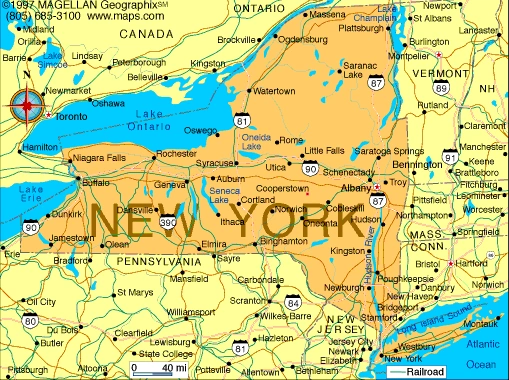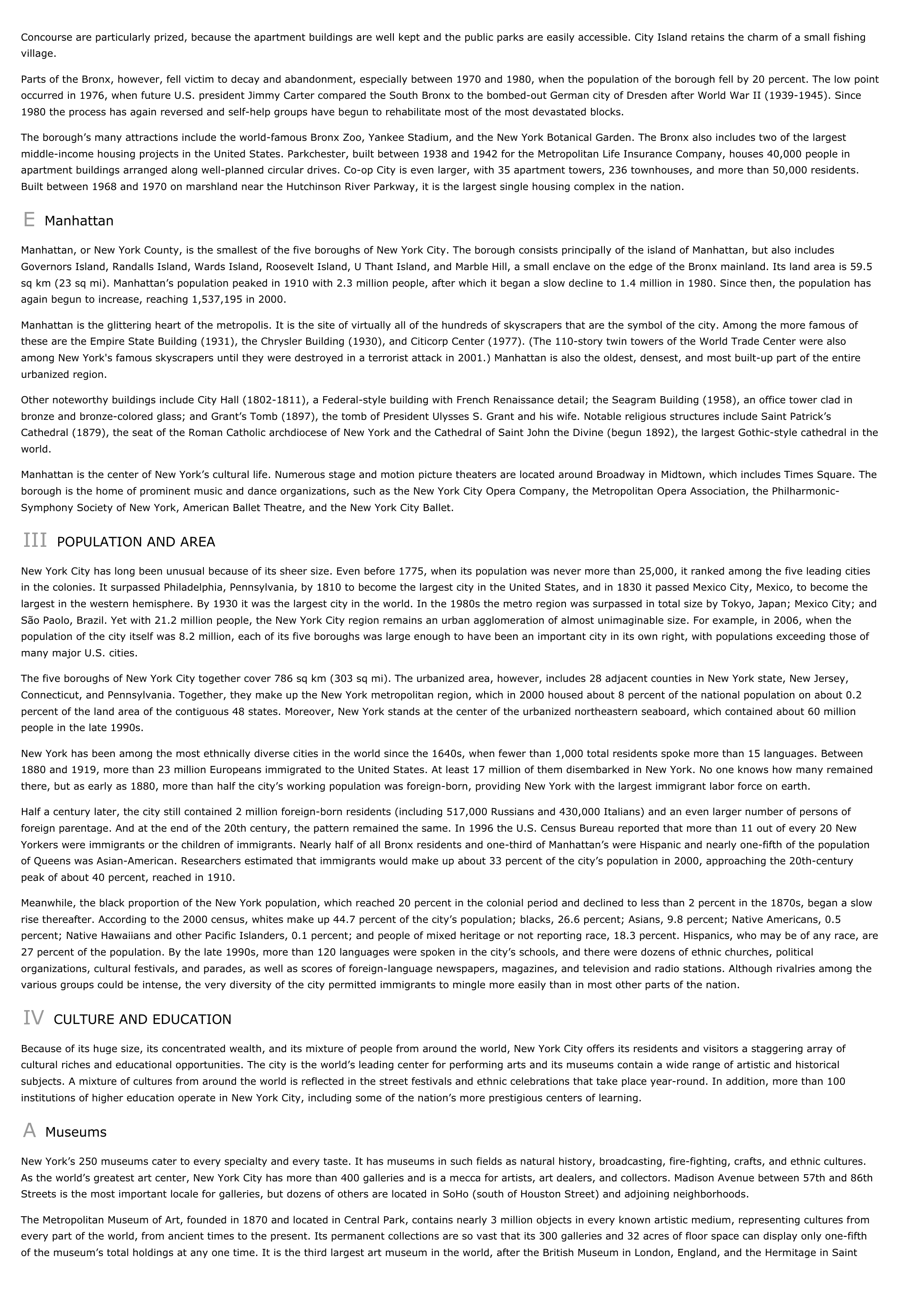New York (city) - geography.
Publié le 27/05/2013

Extrait du document


«
Concourse are particularly prized, because the apartment buildings are well kept and the public parks are easily accessible.
City Island retains the charm of a small fishingvillage.
Parts of the Bronx, however, fell victim to decay and abandonment, especially between 1970 and 1980, when the population of the borough fell by 20 percent.
The low pointoccurred in 1976, when future U.S.
president Jimmy Carter compared the South Bronx to the bombed-out German city of Dresden after World War II (1939-1945).
Since1980 the process has again reversed and self-help groups have begun to rehabilitate most of the most devastated blocks.
The borough’s many attractions include the world-famous Bronx Zoo, Yankee Stadium, and the New York Botanical Garden.
The Bronx also includes two of the largestmiddle-income housing projects in the United States.
Parkchester, built between 1938 and 1942 for the Metropolitan Life Insurance Company, houses 40,000 people inapartment buildings arranged along well-planned circular drives.
Co-op City is even larger, with 35 apartment towers, 236 townhouses, and more than 50,000 residents.Built between 1968 and 1970 on marshland near the Hutchinson River Parkway, it is the largest single housing complex in the nation.
E Manhattan
Manhattan, or New York County, is the smallest of the five boroughs of New York City.
The borough consists principally of the island of Manhattan, but also includesGovernors Island, Randalls Island, Wards Island, Roosevelt Island, U Thant Island, and Marble Hill, a small enclave on the edge of the Bronx mainland.
Its land area is 59.5sq km (23 sq mi).
Manhattan’s population peaked in 1910 with 2.3 million people, after which it began a slow decline to 1.4 million in 1980.
Since then, the population hasagain begun to increase, reaching 1,537,195 in 2000.
Manhattan is the glittering heart of the metropolis.
It is the site of virtually all of the hundreds of skyscrapers that are the symbol of the city.
Among the more famous ofthese are the Empire State Building (1931), the Chrysler Building (1930), and Citicorp Center (1977).
(The 110-story twin towers of the World Trade Center were alsoamong New York's famous skyscrapers until they were destroyed in a terrorist attack in 2001.) Manhattan is also the oldest, densest, and most built-up part of the entireurbanized region.
Other noteworthy buildings include City Hall (1802-1811), a Federal-style building with French Renaissance detail; the Seagram Building (1958), an office tower clad inbronze and bronze-colored glass; and Grant’s Tomb (1897), the tomb of President Ulysses S.
Grant and his wife.
Notable religious structures include Saint Patrick’sCathedral (1879), the seat of the Roman Catholic archdiocese of New York and the Cathedral of Saint John the Divine (begun 1892), the largest Gothic-style cathedral in theworld.
Manhattan is the center of New York’s cultural life.
Numerous stage and motion picture theaters are located around Broadway in Midtown, which includes Times Square.
Theborough is the home of prominent music and dance organizations, such as the New York City Opera Company, the Metropolitan Opera Association, the Philharmonic-Symphony Society of New York, American Ballet Theatre, and the New York City Ballet.
III POPULATION AND AREA
New York City has long been unusual because of its sheer size.
Even before 1775, when its population was never more than 25,000, it ranked among the five leading citiesin the colonies.
It surpassed Philadelphia, Pennsylvania, by 1810 to become the largest city in the United States, and in 1830 it passed Mexico City, Mexico, to become thelargest in the western hemisphere.
By 1930 it was the largest city in the world.
In the 1980s the metro region was surpassed in total size by Tokyo, Japan; Mexico City; andSão Paolo, Brazil.
Yet with 21.2 million people, the New York City region remains an urban agglomeration of almost unimaginable size.
For example, in 2006, when thepopulation of the city itself was 8.2 million, each of its five boroughs was large enough to have been an important city in its own right, with populations exceeding those ofmany major U.S.
cities.
The five boroughs of New York City together cover 786 sq km (303 sq mi).
The urbanized area, however, includes 28 adjacent counties in New York state, New Jersey,Connecticut, and Pennsylvania.
Together, they make up the New York metropolitan region, which in 2000 housed about 8 percent of the national population on about 0.2percent of the land area of the contiguous 48 states.
Moreover, New York stands at the center of the urbanized northeastern seaboard, which contained about 60 millionpeople in the late 1990s.
New York has been among the most ethnically diverse cities in the world since the 1640s, when fewer than 1,000 total residents spoke more than 15 languages.
Between1880 and 1919, more than 23 million Europeans immigrated to the United States.
At least 17 million of them disembarked in New York.
No one knows how many remainedthere, but as early as 1880, more than half the city’s working population was foreign-born, providing New York with the largest immigrant labor force on earth.
Half a century later, the city still contained 2 million foreign-born residents (including 517,000 Russians and 430,000 Italians) and an even larger number of persons offoreign parentage.
And at the end of the 20th century, the pattern remained the same.
In 1996 the U.S.
Census Bureau reported that more than 11 out of every 20 NewYorkers were immigrants or the children of immigrants.
Nearly half of all Bronx residents and one-third of Manhattan’s were Hispanic and nearly one-fifth of the populationof Queens was Asian-American.
Researchers estimated that immigrants would make up about 33 percent of the city’s population in 2000, approaching the 20th-centurypeak of about 40 percent, reached in 1910.
Meanwhile, the black proportion of the New York population, which reached 20 percent in the colonial period and declined to less than 2 percent in the 1870s, began a slowrise thereafter.
According to the 2000 census, whites make up 44.7 percent of the city’s population; blacks, 26.6 percent; Asians, 9.8 percent; Native Americans, 0.5percent; Native Hawaiians and other Pacific Islanders, 0.1 percent; and people of mixed heritage or not reporting race, 18.3 percent.
Hispanics, who may be of any race, are27 percent of the population.
By the late 1990s, more than 120 languages were spoken in the city’s schools, and there were dozens of ethnic churches, politicalorganizations, cultural festivals, and parades, as well as scores of foreign-language newspapers, magazines, and television and radio stations.
Although rivalries among thevarious groups could be intense, the very diversity of the city permitted immigrants to mingle more easily than in most other parts of the nation.
IV CULTURE AND EDUCATION
Because of its huge size, its concentrated wealth, and its mixture of people from around the world, New York City offers its residents and visitors a staggering array ofcultural riches and educational opportunities.
The city is the world’s leading center for performing arts and its museums contain a wide range of artistic and historicalsubjects.
A mixture of cultures from around the world is reflected in the street festivals and ethnic celebrations that take place year-round.
In addition, more than 100institutions of higher education operate in New York City, including some of the nation’s more prestigious centers of learning.
A Museums
New York’s 250 museums cater to every specialty and every taste.
It has museums in such fields as natural history, broadcasting, fire-fighting, crafts, and ethnic cultures.As the world’s greatest art center, New York City has more than 400 galleries and is a mecca for artists, art dealers, and collectors.
Madison Avenue between 57th and 86thStreets is the most important locale for galleries, but dozens of others are located in SoHo (south of Houston Street) and adjoining neighborhoods.
The Metropolitan Museum of Art, founded in 1870 and located in Central Park, contains nearly 3 million objects in every known artistic medium, representing cultures fromevery part of the world, from ancient times to the present.
Its permanent collections are so vast that its 300 galleries and 32 acres of floor space can display only one-fifthof the museum’s total holdings at any one time.
It is the third largest art museum in the world, after the British Museum in London, England, and the Hermitage in Saint.
»
↓↓↓ APERÇU DU DOCUMENT ↓↓↓
Liens utiles
- New York (city) - geography.
- New York City Ballet.
- New York City - geographie.
- Henry Miller Natif de New York City, Miller passa son enfance à Brooklyn.
- Andy Warhol 1928-1987 Peintre américain, de son vrai nom Andrew Warhola, il est né à Forest City et mort à New York.

































